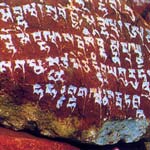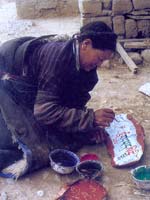|
The Tongtian River, a mythical tributary
By Baying Dongzhub Cerang (China Daily)
Updated: 2004-04-09 10:37

Gyiana Mani stone |
A Kham proverb goes:
"She is a magic river, who snakes through the stars, winds around the moon, passes by the expansive and sacred hills, waterways and pastures and comes down, with the sun rays, to the earth.
She is Tongtian River."
The Tongtian River in Kham's proverb is the tributary where the Tuto River, the origin of the Yangtze River, joins the Tangqu. It runs southeast and passes the Batang outfall in Yushu Tibetan Autonomous Prefecture, in Northwest China's Qinghai Province.
It stretches 813 kilometres, with a drainage area of 138,000 square kilometres.
The Tongtian River area appeals to many people, especially the Tibetans, not only because the river itself is quite mythical; it is also known for its "sutra bridge" and "Gyiana Mani stones."
Sacred platform
Pilgrims who go to the Tongtian River to see the sutra bridge and Gyiana Mani stones usually make their stop first at Gyigu, after trekking over Bayankela Mountain, some 5,000 metres above sea level.

A local woman paints a Mani stone |
Gyigu, once a town of military importance on the south bank of the Tongtian River, is the capital of the Yushu Tibetan Autonomous Prefecture. It used to be a business centre where people from Sichuan, Tibet, Yunnan and Qinghai traded tea and horses, among other items.
The Tongtian River is some 20 kilometres to the east of Gyigu.
People who have lived there for generations believe that the origin of the river comes from a female yak's nostril, and call it the "Yak River" in Tibetan.
The river has been a witness to many events, which have passed down by word of mouth as legends among the local people. Some of the legends relate to a huge dark rock that stands out against the sky on the river's southern side.
Beside the rock, on a gentle slope stand a few old cypresses among sutra flags. The area is well known to the local Tibetans who call it the "Sutra Drying Platform." A holy site, many come to burn aromatic plants as offerings and to replace the sutra flags periodically.
It is said that Xuan Zang, the famous monk of the Tang Dynasty (AD 618-907), arrived at the "platform" on his pilgrimage to India in search of Buddhist scriptures. The Tang monk and his entourage, however, fell into the water while crossing the river.
The local people came to the rescue and helped the monk and his entourage to retrieve their belongings from the water, especially the sutra books the Tang monk was carrying.
The Tang monk laid the sutras out on stones under the sun to dry.
When the sutras were recovered, a line stuck onto the stone and could not be taken off. So the people had it engraved in the surface and it became a Mani stone.
Behind the slope is a small village, where the local people jokingly tell tales of Piggy, a member of the Tang monk's entourage, who tried to get a bride.
Of course, Piggy had to continue with the Tang monk.
Before leaving, Xuan Zang presented a brocade ribbon for binding the Buddhist sutras to the local people to thank them. On the ribbon was written the Buddhist mantra: "Om Mani, Pad-me, Hum."
No one has ever tried to ascertain the authenticity of these legends about the Tang monk and his adventure here at Gyigu. But the tales must have enhanced the area's religious appeal.
On the 10th day of the 12th month in the Tibetan calendar which usually falls on the coldest days in January, the Saiba Monastery of the Gagyu Sect of Tibetan Buddhism holds ritual Mani celebrations by the Tongtian River. The monastery is the home of the Living Buddha, Renqen Cering.
The celebration, which usually starts at about 10 am, attracts countless Tibetans from Gyigu and neighbouring villages. Many come from as far as the Tibet Autonomous Region and Sichuan, and some even try to do business.
Well before the celebration starts, pilgrims arrive by the river carrying bags of sand with them.
They carve lines on the ice of the water. When silver sand is spread on the lines, the six-syllable mantra "Om Mani, Pad-me, Hum" appears. The big words of the prayer stretch across the river linking the two sides.
This is what the local Tibetans call building a sutra bridge. Often some 100 people join in its creation and it can take more than half a day to finish it.
All the participants are delighted to join in the work, because they believe the hard work is part of strengthening their religious beliefs. When the sutra bridge is completed, the giant sandy words look like a bas-relief sculpture on the surface of the river.
As the sand absorbs the sunshine and becomes warm, the ice beneath the words melts and the sand settles on the river bed, creating an engraved work of religious belief in the river.
In the late spring, when the ice melts, people can still see the lines made of sand through the crystal clear water. The local Tibetans say humans can only create the sand work, but nature follows to bring about its own production.
Gyiana Mani stones
Along a narrow tributary of the Tongtian River 5 kilometres east of Gyigu is the Xinzhai (New Stockaded) Village. The legendary Gyiana Mani, or the City of Mani Stones, is located at the western end of the village. Like an old white castle, the cluster of stones extends 282 metres in length and 75 metres across, and rises 3 metres.
Mani stones, products of Tibetan Buddhism, are considered small natural vehicles for Buddhists to pray, worship and communicate with the Buddha.
The history of Gyiana Mani extends back more than 300 years. It is said that in 1687, the first Living Buddha in Gyigu Monastery built the Mani stone city on a fine Mani stone brought from inland China. The local Tibetans called it "Gyiana," the phrase the local people use to describe the Central Plains areas.
It is the biggest of its kind in China. Gyiana Mani is famous not only in China, but also in India, Nepal, and Bhutan. For hundreds of years, stones have been quarried from the mountains, but only in the mountains around Xinzhai Village do people find very white, clean and fine stones.
Visitors to the Mani stone city must walk through the Xinzhai Village. At the village entrance, a few elderly people and children hawk various Mani stones. People on a ritual walk stop to buy a stone to place on the Gyiana Mani, to pray for peace and good fortune.
The villagers make a living by carving the words of prayers on the Mani stones for the pilgrims.
The village has a sutra-carving group with four members, who organize the villagers in the production and trade of Mani stones and manage and build the Gyiana Mani.
The stones that bear lines from Buddhist sutras are first dyed red. Letters are then carved in white by recess inscription. Only those stones that bear the six-syllable mantra are brightly coloured.
Local people believe that the colours white, blue, yellow, green, red and black represent the five Buddhas that will eradicate people's hatred, worries, greed, jealousy, ignorance and sins.
Apart from carving the Mani stones, Xinzhai villagers have also inherited and developed a religious "Cho" dance, unique to Tibetan-inhabited areas in Qinghai.
It is performed by men only, and is an indispensable folk dance accompaniment to the Gyiana Mani ritual rally.
Temple fairs on the prairie are basically religious celebrations, but the Gyiana Mani ritual rally is different. It includes a bazaar, which was a trade market for farming and herding products, but has now become a material exchange fair.
|
